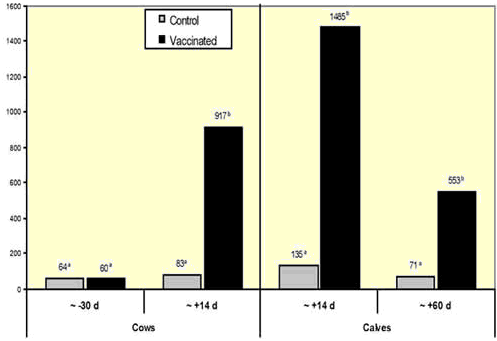



The Use of an Experimental Vaccine in Gestating Beef Cows to Reduce the Shedding of <i>Escherichia coli </i>O157:H7 in the Newborn Calf
By Travis Standley, Extension Agent, Montana State University Extension. Escherichia coli O157:H7 is one of several food-born pathogens which may be found in beef.E. coli O157:H7 is associated with hemorrhagic colitis. Intensive research by universities targeting elimination or reduction of fecal 0157:H7 shedding in cattle has been conducted for the past ten years. The Federal Register (2002) reported that five multistate studies showed the apparent prevalence in breeding herds containing one or more animals infected with E. coli O157:H7 were 24%, 61%, 75%, 87% and 100%.
In addition, three other multi-state studies reported the apparent prevalence in feedlots containing one or more cattle infected with E. coli O157:H7 was 63%, 100% and 100%. Similarly, Smith, et al. (2001) reported that the fecal prevalence of E. coli O157:H7 in fed cattle was 23%.
Post-harvest interventions in the packing plants have dealt with controlling food borne pathogens in multiple hurdle approaches. In order to reduce pathogen contamination in primarily ground beef, recent work has focused more on preharvest methods to reduce the incidence of E. coli O157:H7.
The objectives of this study were to determine if an experimental E. coli O157:H7 vaccine given to gestating beef cows would result in transferring E. coli antibodies to the newborn calf via colostrum.
The experiment was conducted at the USDAARS- LARRL Research Station at Miles City (Ft. Keogh), Mont. One hundred and thirty seven gestating beef cows in the last trimester of pregnancy were used for this study. Cows were weighed and randomly assigned to the two treatments (Control vs. Vaccinated with E. coli) approximately 30 days prior to the start of expected calving. Seventy-one of the gestating cows were vaccinated with the experimental vaccine, (developed by Fort Dodge Animal Health Laboratories) which was designed to prevent the attachment of E. coli O157:H7 to the intestinal wall and then co-mingled with 66 non-vaccinated control cows. Cows remained in calving pens for the first 15 days after parturition and then were moved to native range pastures.
The initial antibody titer levels were similar for cows at time of vaccination, but when sampled at approximately 14 days after parturition the E.coli O157:H7 vaccinated cows had titers which were significantly higher than the control cows (Figure 1).
The initial titer levels of the calves, which were collected within 14 days of parturition, showed a ten fold difference (P less than 0.001) between treatments (135 vs. 1485 for Control calves vs. calves which suckled vaccinated cows respectively). Titer levels at branding (~60 d) showed a slight decrease in titer levels, but calves from vaccinated cows were still seven times higher (P less than 0.001) than the control calves.
Methods to reduce the shedding of E. coli O157: H7 would be useful in controlling the potential contamination of meat. Results of this experiment showed that vaccinating the gestating cow with an experimental vaccine against Escherichia coli O157:H7 resulted in increased antibody titers in both the cow and her calf.
 a, b Unlike means within a time period are different (P less than 0.05)
a, b Unlike means within a time period are different (P less than 0.05) March 2007


